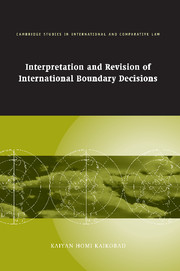Book contents
- Frontmatter
- Contents
- List of maps
- Preface
- Acknowledgments
- Table of cases
- List of abbreviations
- Part I Introduction
- Part II The settlement of territorial and boundary disputes
- Part III Judicial remedies: interpretation
- Part IV Judicial remedies: revision
- 7 The revision of judgments and awards
- 8 General features of revision
- 9 The classification of the notion of revision
- 10 Issues of admissibility
- 11 Selected substantive and procedural aspects of revision
- Part V Conclusions
- Select bibliography
- Index
- CAMBRIDGE STUDIES IN INTERNATIONAL AND COMPARATIVE LAW
9 - The classification of the notion of revision
Published online by Cambridge University Press: 14 September 2009
- Frontmatter
- Contents
- List of maps
- Preface
- Acknowledgments
- Table of cases
- List of abbreviations
- Part I Introduction
- Part II The settlement of territorial and boundary disputes
- Part III Judicial remedies: interpretation
- Part IV Judicial remedies: revision
- 7 The revision of judgments and awards
- 8 General features of revision
- 9 The classification of the notion of revision
- 10 Issues of admissibility
- 11 Selected substantive and procedural aspects of revision
- Part V Conclusions
- Select bibliography
- Index
- CAMBRIDGE STUDIES IN INTERNATIONAL AND COMPARATIVE LAW
Summary
Preliminary observations
In keeping with the classification offered in Chapter 4 above with respect to interpretation, revision can also be divided into two basic kinds, namely, revision which is incidental to the main proceedings, and revision which is not incidental but is in fact the main case before the tribunal. While the basic distinguishing criteria for the classification offered are the same, the two judicial remedies, on account of their legal nature, are in fact asymmetrical in their classification.
Revision incidental to the main case
Revision is incidental where it takes place in proceedings supplementary or ancillary to the main case. Such proceedings can come about either as a result of ad hoc arbitral proceedings, not unlike Request for Revision and Interpretation of the 1994 Judgment, or under Article 61 of the Statute of the International Court of Justice, for example, Application for Revision and Interpretation of the 1982 Judgment and El Salvador v. Honduras. They may also come about under Article 83 of the 1907 Hague Convention for the purposes of the Permanent Court of Arbitration.
The difference between ad hoc incidental revision, including applications under the Hague Convention, and incidental revision under the Statute of the International Court of Justice is that, while the criteria provided under the Statute cannot be varied – or, if they are, the varied provisions are in principle unenforceable where their application or interpretation is contested by one of the contracting parties – ad hoc arbitral agreements can empower tribunals to revise their judgments on the bases of varying criteria.
- Type
- Chapter
- Information
- Interpretation and Revision of International Boundary Decisions , pp. 261 - 264Publisher: Cambridge University PressPrint publication year: 2007

